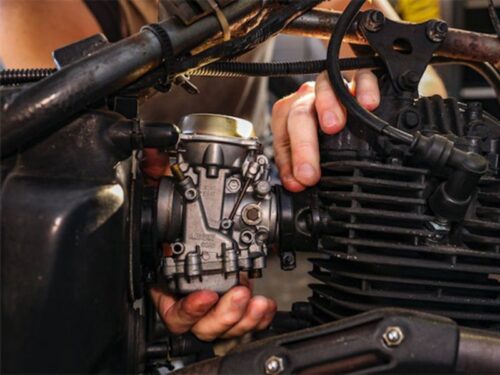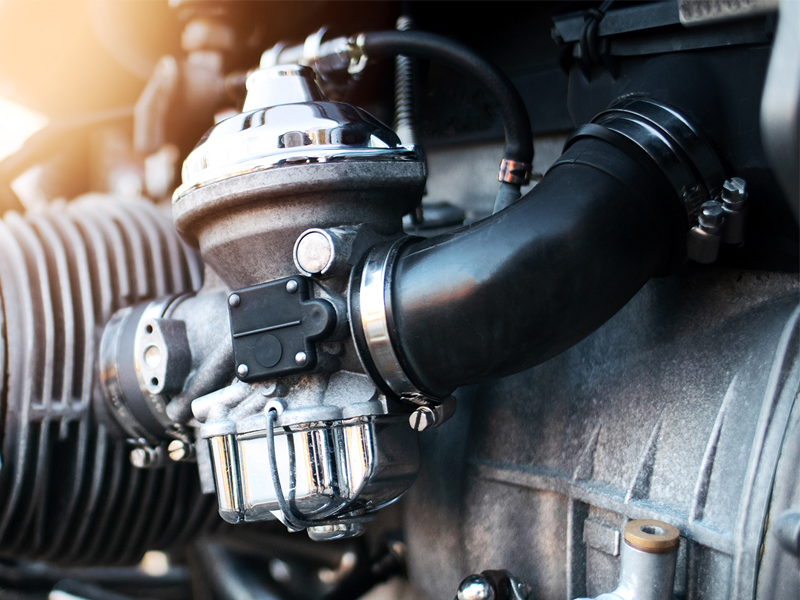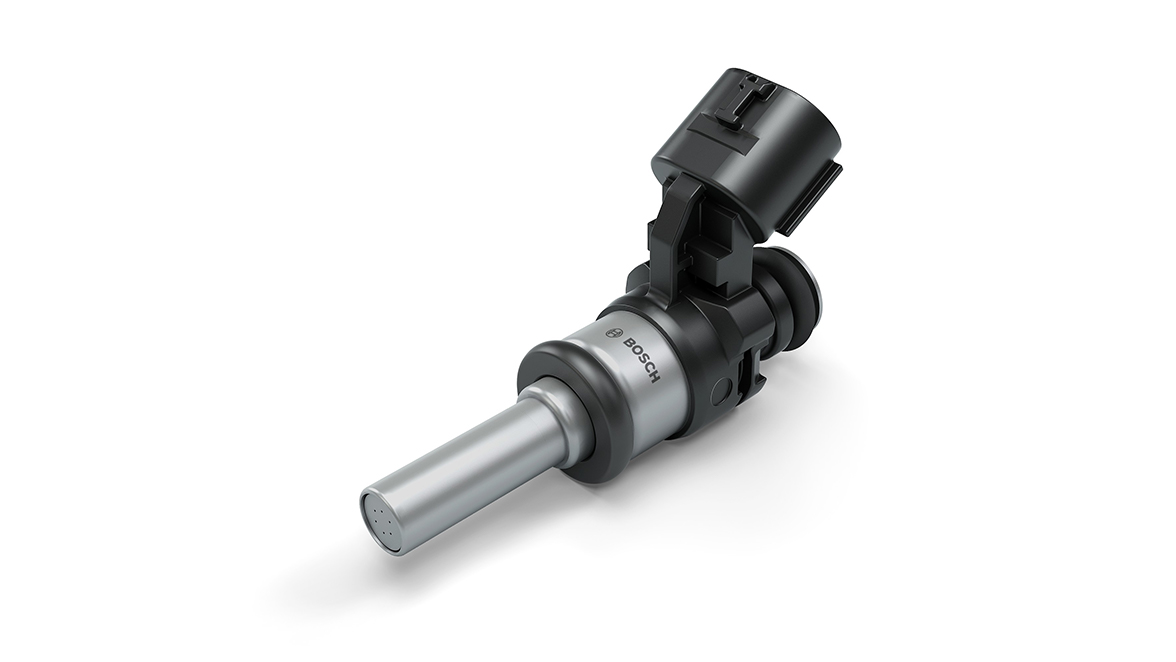
Long story short: When comparing Fuel Injection vs Carburetor systems, Fuel injection is superior in performance, efficiency, and emissions, while carburetors have advantages only in maintenance and cost.
A motorcycle engine powers the wheels by igniting a mix of petrol and air. This mixture, prepared by either a carburetor or a fuel injection system, is vital for engine function.
Key Takeaways
- A carburetor mixes fuel and air to enable combustion inside a motorcycle engine, then delivers this mixture to the engine’s intake.
- In motorcycles, various types of fuel injection systems are employed, primarily electronic fuel injection (EFI), with variations including port injection and direct injection.
- Fuel injection beats carburetors in most areas except for maintenance and cost. This change lowers emissions but also raises motorcycle prices.
- Repairs to fuel injection systems typically require expert knowledge and specialised tools.
- Due to new emission regulations, manufacturers are transitioning to fuel injection to comply with Bharat Stage 6 standards.
This article compares the pros and cons of fuel injection and carburetors by explaining how each system works, starting with carburetors.
What is a carburetor?
A motorcycle carburetor is a mechanical device responsible for mixing air and gasoline in the correct ratio to produce a combustible fuel-air mixture that powers the engine. It is located between the air intake and the engine cylinder.
How does a carburetor work?
Let’s break down how a motorcycle carburetor works into simple steps:
- Air Intake: The carburetor draws in air from outside through its intake opening. The amount depends on the throttle position, and during cold starts, the choke can restrict air to help the bike start more easily.
- Venturi Effect: Air passes through a narrow passage (venturi). This causes the air speed to increase and the pressure to drop, creating suction.
- Fuel Metering: The drop in pressure draws fuel up from the float chamber through small jets. The main jet supplies fuel at high speeds, while the pilot jet controls fuel at idle and low throttle.
- Fuel Atomisation: The fast-moving air mixes with fuel, breaking it into tiny droplets for better combustion.
- Throttle Valve Control: Twisting the throttle by the rider opens the throttle valve, letting in more air, which creates more suction and pulls in additional fuel. More fuel and air equals more power.
- Air-Fuel Mixture Formation: The carburetor ensures the right ratio of air to fuel by balancing airflow (via throttle) and fuel flow (via jets and float).
- Combustion Chamber Delivery: The mixed air-fuel is sent into the engine cylinder, where it’s compressed by the piston.
- Ignition and Combustion: The spark plug ignites the compressed mixture, powering the engine to move the motorcycle.
- Exhaust Stroke: Burnt gases are expelled from the cylinder, making room for the next fresh mixture.
- Cycle Continuation: This process repeats continually as long as the bike is running.
Types of bike carburetor
There are mainly 5 types of motorcycle carburetors, and they are
| Carburetor Type | Description | Examples |
|---|---|---|
| Constant Velocity (CV) | Uses vacuum to operate a slide, balancing airflow and fuel, providing smooth throttle response and better fuel efficiency. Ideal for commuter bikes. | Hero Splendor, Bajaj Platina, Honda CB Shine, TVS Star City, Hero HF Deluxe |
| Slide / Mechanical Slide | Uses a slide directly controlled by the throttle cable for quick throttle response and moderate fuel efficiency. Suitable for performance and sportier bikes. | Royal Enfield Classic 350 (older carbureted models), Bajaj Pulsar 150 (older models), Yamaha FZ-S V2.0 (older carbureted variants) |
| Butterfly Carburetor | Uses a butterfly valve for airflow control; common in older motorcycles with less smooth throttle response. | Older models of Bajaj Chetak, older scooters like TVS Jupiter carbureted variants |
| Downdraft Carburetor | Positioned above the inlet manifold, allowing the air-fuel mixture to move downward into the engine, suitable for high-performance bikes. | Rare in Indian motorcycles but seen in performance variants of older sport bikes imported or customised |
| Updraft Carburetor | Air flows upward; found mostly in vintage motorcycles. | Classic and vintage motorcycles like early Royal Enfield Bullet carbureted versions |
- Most modern commuter bikes in India utilise CV carburetors for enhanced efficiency and smoothness.
- Older performance-oriented motorcycles with quicker throttle response use slide carburetors.
- Vintage and classic bikes typically feature updraft or butterfly carburetors.
- Downdraft carburetors are less common but are used in specialised or performance bikes.
- carburetors have mainly been replaced by fuel injection in new motorcycles due to stricter emission standards, such as those of BS-6.
Advantages of motorcycle carburetor
- Cost-Effective: carburetors are generally cheaper to purchase and repair. They are ideal for budget-friendly motorcycles and low-capacity engines, making them accessible to a wide range of riders.
- Simplicity and Maintenance: carburetors are simpler mechanical devices, which makes them easier to maintain and repair. They can be serviced by most mechanics and are customisable to meet user demands and surroundings.
- Tolerance to Fuel Quality: carburetors are more tolerant of substandard fuel and can be easily cleaned if contaminated, which can be beneficial in areas with inconsistent fuel quality.
Disadvantages of motorcycle carburetor
- Cold Start Issues: Carbureted motorcycles often struggle with starting in cold weather and at higher altitudes without adjustment, which can be inconvenient for riders in such conditions.
- Fuel Efficiency and Emissions: carburetors have lower fuel efficiency and tend to produce higher emissions due to less efficient combustion, making them less environmentally friendly.
- Performance Limitations: They struggle to deliver reliable power across all load and RPM ranges. They need to be more careful to tune to pass emissions regulations while maintaining drivability.
- Maintenance Needs: carburetors require periodic adjustments or tuning and are more prone to fuel and air leaks compared to fuel injection systems.
Next, look at fuel injection.
What is fuel injection, and how does fuel injection work?
Motorcycle fuel injection is a modern system that precisely controls the delivery of fuel into the engine’s combustion chamber. Unlike a carburetor, which mixes air and fuel mechanically, the fuel injection system uses electronic sensors and an engine control unit (ECU) to meter the right amount of fuel for optimal performance.
Here’s a simple, stepwise explanation of how a motorcycle fuel injection system works:
- Fuel pump activates: When you turn the key, the fuel pump sends fuel from the tank under high pressure to the fuel injectors.
- Sensors collect engine data: Various sensors (like those measuring throttle position, engine temperature, and air pressure) feed real-time data to the electronic control unit (ECU).
- ECU calculates requirements: The ECU (motorcycle’s computer) instantly calculates the right amount of fuel needed for the current engine and riding conditions, using a pre-set fuel map.
- Throttle input (rider control): When you twist the throttle, it changes the amount of air entering the engine (via throttle valve or ride-by-wire). The ECU senses this and adjusts fuelling accordingly.
- Injector sprays fuel: The ECU sends a signal to the injector, which opens for a precise time. The injector sprays fuel as a fine mist into the intake manifold or directly into the cylinder (depending on design).
- Air mixes with fuel: The atomised fuel mixes with incoming air to form a uniform air-fuel mixture.
- Mixture enters engine: This mixture is drawn into the cylinder, then compressed by the piston.
- Combustion: The spark plug ignites the mixture, producing the power needed to move the motorcycle.
- Real-time adjustments: The ECU continuously monitors sensors and adjusts injection timing & quantity for precision, efficiency, and emissions control.
Types of Fuel injection
In motorcycles, various types of fuel injection systems are employed, primarily electronic fuel injection (EFI), with variations including port injection and direct injection, depending on the model and brand.
1. Electronic Fuel Injection (EFI) – Port Injection
The most common type of fuel injection in Indian motorcycles. Fuel is injected near the intake valve (intake port) for better atomisation and combustion. EFI systems usually consist of sensors and an ECU that precisely controls the fuel flow based on engine conditions.
Examples:
2. Direct Injection (DI)
An advanced system where fuel is injected directly into the combustion chamber. Improves power delivery, fuel efficiency, and reduces emissions. Used in performance-oriented motorcycles.
Examples:
Advantages of motorcycle fuel injection
- Cold Start Performance: Fuel-injected motorcycles excel in cold start conditions, starting easily without the need for manual choking. The system automatically adjusts the air-fuel mixture according to the prevailing conditions.
- Fuel Efficiency and Emissions: Fuel injection systems offer better fuel economy and lower emissions due to precise fuel injection and efficient combustion.
- Engine Performance: Fuel-injected engines generally provide higher power output and are suitable for high-performance applications.
- Reliability and Maintenance: These systems are generally more reliable and require less maintenance over time. They are less prone to issues like engine vibrations and fouled spark plugs.
Disadvantages of motorcycle fuel injection: Fuel Injection vs carburetor
- Complexity and Cost: Fuel injection systems are more complex, involving numerous sensors, wiring, and a computer unit, which can fail. They are also more expensive than carburetors.
- Repair and Replacement: Diagnosing and repairing fuel injection systems can be challenging, often requiring specialised services. If damaged, the entire system may need to be replaced.
- Sensitivity to Fuel Quality: Fuel injection systems, particularly newer direct injection types, are more sensitive to fuel quality, which can affect performance.
Fuel Injection vs Carburetor comparison
You now know how carburetors and fuel injection work. Let’s compare them:
| Parameter | carburetor | Fuel Injection |
|---|---|---|
| Fuel Delivery | Mechanical mixing of air and fuel | Electronic control with sensors and ECU |
| Fuel Efficiency | Lower due to fixed air-fuel ratio | Higher due to precise and adaptable control |
| Engine Performance | Less efficient and less responsive | Better throttle response and optimized power |
| Cold Start | Difficult, requires choke | Easy, no choke needed |
| Maintenance | Simpler, easier to clean and repair | Complex, requires specialized tools |
| Repair Cost | Lower, inexpensive parts | Higher, costly electronic parts |
| Adaptability | Needs manual adjustment for altitude, temp | Automatically adjusts to riding conditions |
| Emissions | Higher pollution | Lower emissions |
| Durability | Good but prone to clogging | Generally durable, sensitive electronics |
| Replacement | Easy, widely available | Difficult, specialized parts |
| Initial Cost | Lower initial cost | Higher initial cost |
| Overall Reliability | Susceptible to dirt causing frequent tuning | More reliable with less frequent tuning |
| Environmental Impact | Higher due to inefficient combustion | Lower due to optimized combustion |
Fuel injection beats carburetors in most areas except for maintenance and cost. Due to new emission regulations, manufacturers are transitioning to fuel injection to comply with Bharat Stage 6 standards. This change lowers emissions but also raises motorcycle prices. Repairs to fuel injection systems typically require expert knowledge and specialised tools.
What are the specific performance advantages of fuel injection over carburetors in various riding conditions in a motorcycle?
Fuel injection offers several specific performance advantages over carburetors in various riding conditions in motorcycles:
- Precise Fuel-Air Mixture and Atomisation: Fuel injection systems use sensors and the ECU to measure and deliver the exact amount of fuel needed, optimising combustion efficiency. This results in cleaner, more efficient fuel burning across different conditions compared to carburetors, which rely on mechanical mixing with less precision.
- Adaptability to Riding Conditions: Fuel injection automatically adjusts the air-fuel mixture based on changes in altitude, temperature, and humidity. For example, at higher altitudes where oxygen levels drop, fuel injection compensates to maintain performance without manual tuning, unlike carburetors that need manual adjustments or different jets.
- Sharper and Quicker Throttle Response: The electronic control of fuel injection allows immediate fuel delivery matching throttle input, providing smoother and more responsive acceleration. carburetors have a slower mechanical response and can be less consistent in throttle feedback.
- Cold Start Performance: Fuel injection enables easier and more reliable engine starting in cold conditions without the need for a choke, which is often required for carburetted engines. This smooth, cold start contributes to better overall performance, especially in varying climates.
- Better Fuel Efficiency and Mileage: The accuracy of fuel delivery in fuel injection systems leads to better fuel economy, as fuel is not wasted burning rich or lean mixtures common in carburetors under changing conditions. This advantage is particularly evident in mixed or urban riding conditions, where throttle and load vary frequently.
- Lower Maintenance and Emissions: Fuel injection systems require less regular tuning and maintenance than carburetors, and they produce lower exhaust emissions due to optimised combustion. This makes them more durable and environmentally friendly.
To summarise, fuel injection provides consistent engine performance and improved fuel efficiency. It handles various riding conditions well, including cold starts, changes in altitude, and temperature fluctuations. carburetors struggle to keep up because they are mechanical and less adaptable.
How does the complexity of a fuel injection system affect its long-term maintenance compared to a carburetor in a motorcycle?
The complexity of a fuel injection system does affect its long-term maintenance compared to a carburetor in motorcycles in several ways:
- Higher Complexity and Specialised Knowledge Required: Fuel injection systems involve electronic components like sensors, ECU, and injectors, making them more complex than primarily mechanical carburetors. This complexity means that maintenance and tuning require specialised tools and expert knowledge, unlike carburetors, which can be serviced or tuned more easily by riders or general mechanics.
- Less Frequent Routine Maintenance: Fuel injection systems generally need less frequent maintenance because they don’t suffer from issues like clogged jets or float bowl problems common in carburetors. They are more resistant to dirt and contamination, but require periodic checks on sensors and the fuel pump.
- Higher Repair Costs: If a fuel injection system fails, the repair or replacement costs can be significantly higher than carburetor repairs. Every fuel injection system is often unique, making parts and repairs more expensive and time-consuming compared to the simpler carburetor parts.
- Dependence on Electronics: Fuel injection systems are highly reliant on electronic components, so a single sensor or ECU failure could cause multiple performance issues, complicating diagnosis and repair. carburetors, being mechanical, are less susceptible to electronic failures.
- Ease of DIY Maintenance: carburetors are considered easier and more accessible for amateur riders or mechanics to maintain at home due to their mechanical simplicity. Fuel injection maintenance, on the other hand, is often better performed by professionals due to the technical complexity.
- Maintenance Benefits: Despite the complexity, fuel injection systems offer advantages like no need for manual tuning for altitude or temperature, no choke for cold starts, and more consistent fuel delivery, which reduces the need for constant adjustments that carburetors require.
In summary, fuel injection systems are more complex and expensive to repair. Still, they require less maintenance and are generally more reliable. carburetors are easier and cheaper to fix, and you can often maintain them yourself; however, they need more regular tuning and cleaning.
FAQ related to motorcycle fuel injection vs carburetor
1. How does a fuel injection system differ from a carburetor?
Fuel injection systems utilise electronic sensors and an engine control unit (ECU) to deliver fuel directly into the combustion chamber, resulting in a more precise air-fuel mixture compared to the mechanical operation of carburetors.
2. Which gives more mileage, carburetor or fuel injection?
The fuel injection system gives more mileage as fuel delivery to the engine is done based on inputs from the various sensors and factors in the Fi system. Therefore, the right amount of fuel is delivered, resulting in increased mileage.
3. Which provides more performance, Fi or carburetor?
Fuel injection systems enhance motorcycle performance by providing a precise air-fuel mixture, resulting in higher power output and better fuel management.
4. What are the signs of failure of the carburetor & Fi?
Failure signs include starting issues, poor idling, reduced mileage, the engine not reaching the intended RPM, and increased smoke from the exhaust.
5. Which one is better for cold conditions, the carburetor or Fi?
Fuel injection systems perform better in extreme weather conditions, providing consistent performance and easier starting in cold weather, unlike carburetors, which can struggle in such situations.
6. Why has the fuel injection system replaced the carburetor on bikes launched recently?
Fuel injection is mandatory for a motorcycle to comply strictly with BS-6 emission norms. Even low-displacement motorcycles now use Fi in India.
7. Does the Fi or the carburetor last longer, and which one has less wear and tear?
Fuel Injection lasts longer and causes less wear and tear compared to a carburetor.
Other related articles from Bikeleague India
- Adventure bikes vs Touring bikes which one is the best
- Yamaha vs Honda vs Kawasaki : Comparing Bike Giants
- Fuel Priming Pump Guide: Usage & Care for Indian Bikes
- Motorcycle Cruise Control – All you need to know
- Zontes 350T ADV
Conclusion
We don’t need a separate section to choose a winner—fuel injection is clearly the better option. The main drawbacks are its higher cost and the need for expert help if repairs are needed. In all other ways, fuel injection is ahead. carburetors can’t adapt to changing weather, use more fuel, and burn it less efficiently. We hope this article has answered your questions and made your decision easier.
If you have any questions, feel free to email us at bikeleague2017@gmail.com or leave a comment below. We’re always happy to help. You can also connect with Bikeleague India on our social media platforms.



